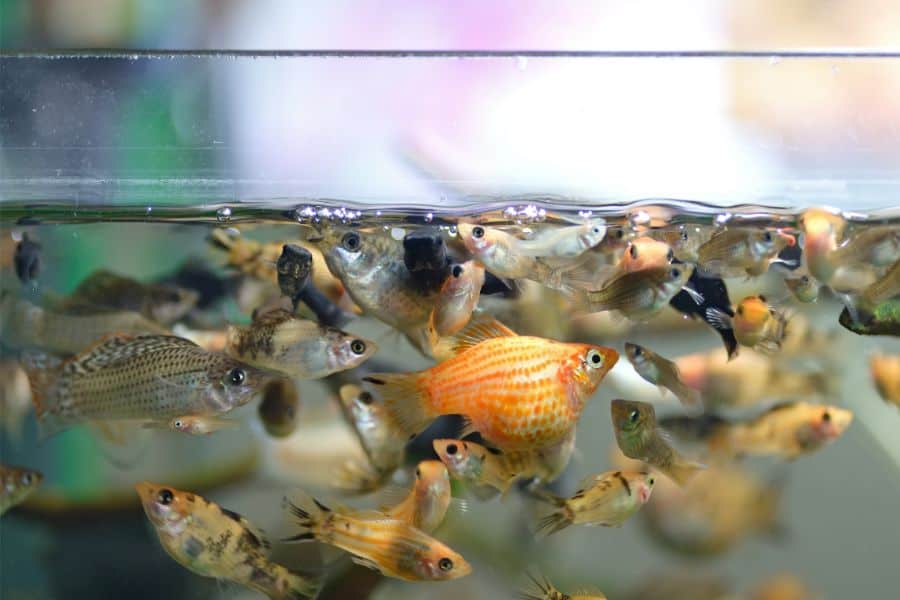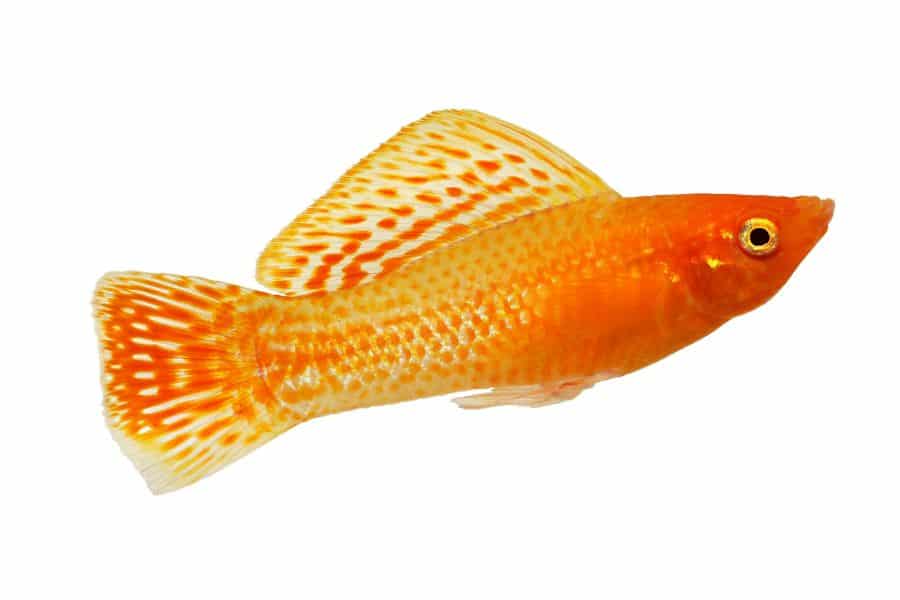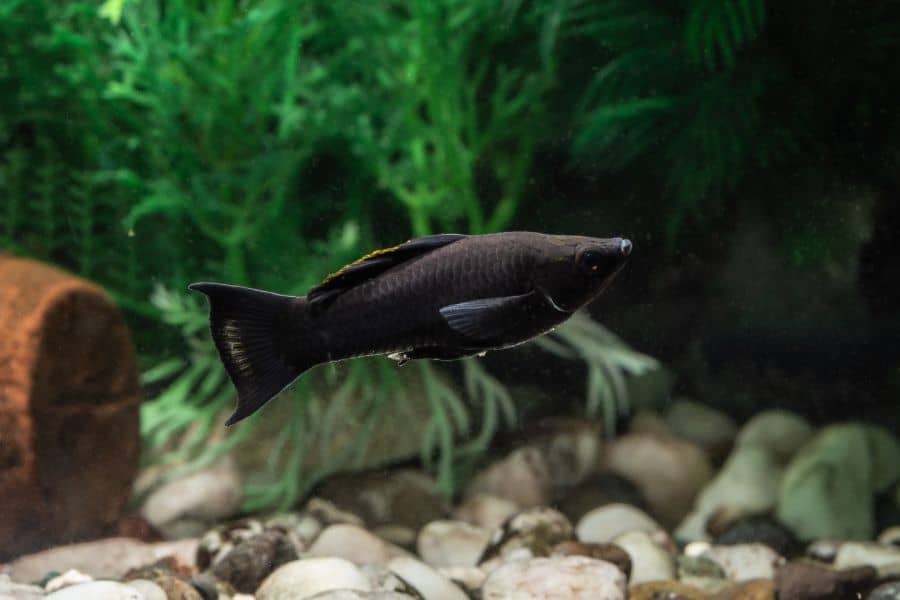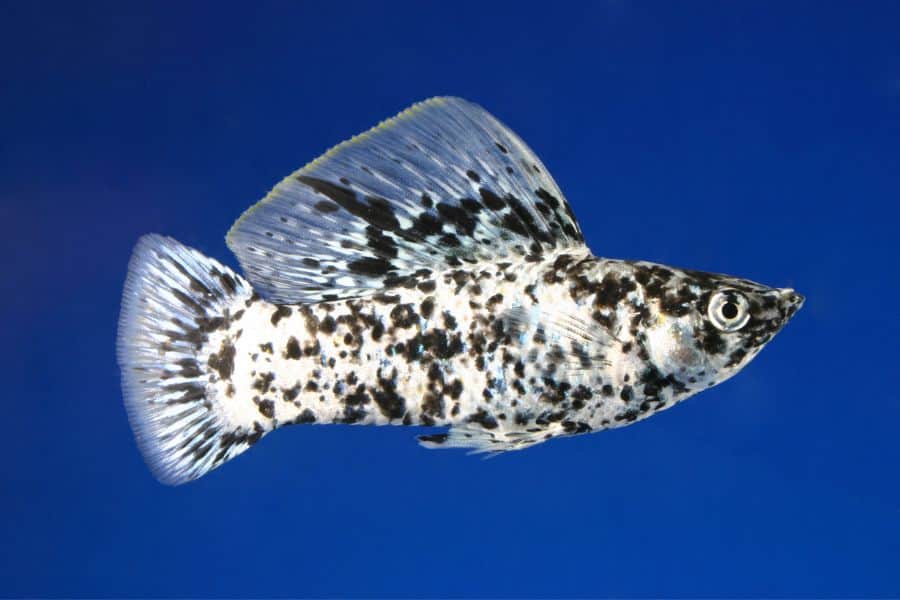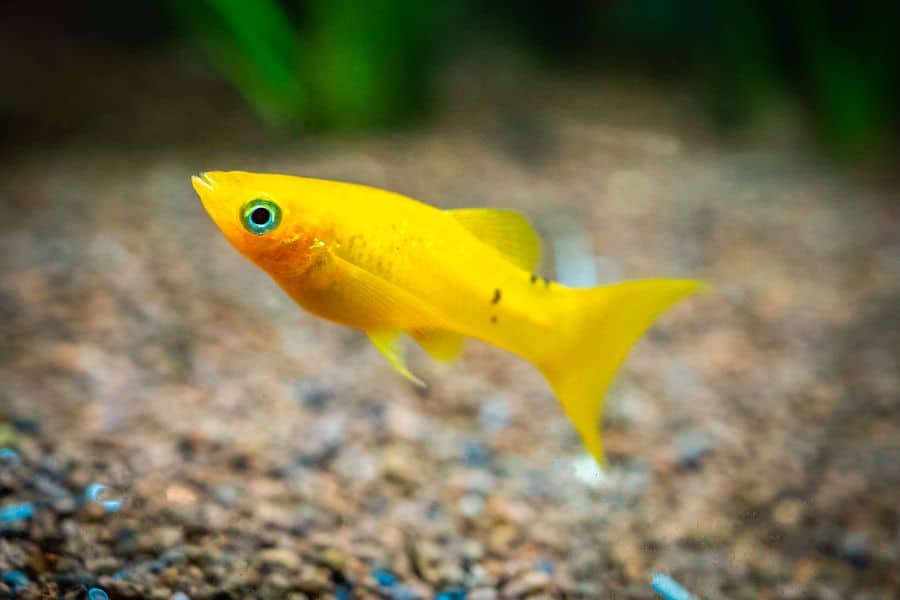Molly fish or mollies are arguably the most popular aquarium fish. They are peaceful, easy to care for, and add an aesthetic appeal to your tank with their unique colors and patterns. Besides, they help to control algae growth, keeping the tank clean.
Do you want to learn more about these fascinating aquarium creatures?
Well, this comprehensive guide covers everything on molly fish, including their tank requirement, care, nutrition, and even breeding. And that’s not all! We’ve also highlighted a few types of molly fish for you to consider.
Let’s begin!
Molly Fish Overview
| Scientific Name | Poecilia sphenops |
| Genus | Poeciliida |
| Family | Poecilia |
| Popular Name | Molly, Molly Fish, Common Molly |
| Maximum Tank Size | 10 to 50 gallons |
| Lifespan | 3-5 years |
| Care Level | Easy |
| Behavior and Temperament | Peaceful |
| Diet | Omnivores |
| Average Size | 4-5” |
| Water pH | 7.0 – 8.0 |
| Water Hardness | 20-30 dkh |
| Water Temperature | 72–80 °F |
Mollies are freshwater fish belonging to the genus Poecilia. They are several species of molly fish, including the well-known common molly Poecilia sphenops and the Sailfin molies (Poecilia latipinna and Poecilia velifera). Hybrid species also exist like Poecilia formosa, which is a cross between P. sphenops and P. latipinna.
Native to North, South, and Central America, molly fish thrive in fresh and saline waters. They are often found in slow-moving rivers, streams, lagoons, brackish ditches, and shallow marine waters.
In the wild, mollies have a dull, silvery-gray color. But those bred in captivity display a variety of colors and patterns. Another thing, they are exceptionally good at cleaning aquariums since they eat algae and leftover food.
Physical Appearance
Sure, different types of mollies exist, but they all have the same appearance. Molly fish have flattened bodies and triangular-shaped heads with big eyes and a lower jaw that sticks out a little. They come with a wide midsection and their body assumes a narrow shape towards the snout.
However, male and female molly fish display a few differences based on their physical appearance. Female mollies usually have large, slightly round bodies, whereas males have small, flat bodies.
During pregnancy, their differences become even more obvious. The females develop a gravid spot (a dark coloration) on the lower side of the belly.
The shape of the anal fin can also help in differentiating male and female mollies. Females have a triangular-shaped anal fin, while the males have a modified (tube-shaped) anal fin called “gonopodium. Both male and female mollies have a dorsal fin, but it’s more prominent in males than in females.
In addition, molly fish come in an array of colors, including:
- Black: Some mollies have solid black bodies with orange, gold, or silver details on their tail fins. The shade of black exhibited by these mollies is unique because it results from a severe case of melanism.
- Orange: Besides black, mollies can have orange bodies with white underbelly or black spots spread throughout their bodies.
- White: It’s not uncommon to find mollies with white or reflective silver bodies. However, some mollies develop white coloration because of albinism, a condition where the fish produces no color pigment.
- Yellow: Mollies can have completely yellow bodies or patches of black or white, especially on their underbelly.
Besides these, we have a few rare molly fish colors, such as blue, spotted (black and white), and red.
Average Size and Lifespan
In captivity, molly fish can grow to an average size of 4 to 4.5 inches. But females can reach a maximum length of 5 or 6 inches, especially Sailfin mollies. Because of their manageable size, mollies can thrive even in small tanks.
But remember, your pet fish’s growth is directly proportional to the aquarium environment, nutrition, care level, and other factors.
As for their lifespan, most molies live between 3 to 5 years in aquariums. If you need a pet fish with a longer lifespan, look into other species, like angelfish, neon tetras, plecostomus, Oscars, or goldfish. However, if this is not your requirement, you will love keeping a molly fish.
With proper care, diet, and a clean, healthy environment, you can ensure your molly has a long and healthy life.
Molly Fish Types
As mentioned earlier, there are many variants of molly fish both natural and selectively bred. In this section, we’ve discussed the different molly fish types. Check them out!
Natural Mollies
1. Common Molly Fish
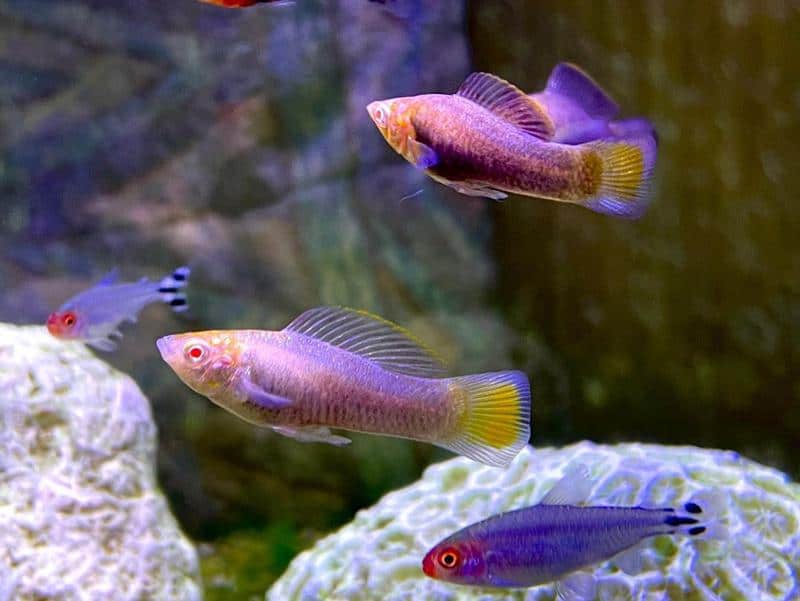
The common molly or short-finned molly is a wild fish species found in slow-moving rivers, streams, and shallow, brackish coastal waters.
It’s a hardy and highly adaptable fish that thrives in tanks with plenty of plants and hiding spots. However, common mollies are not common in aquariums today because of their dull coloration.
2. Dwarf Molly
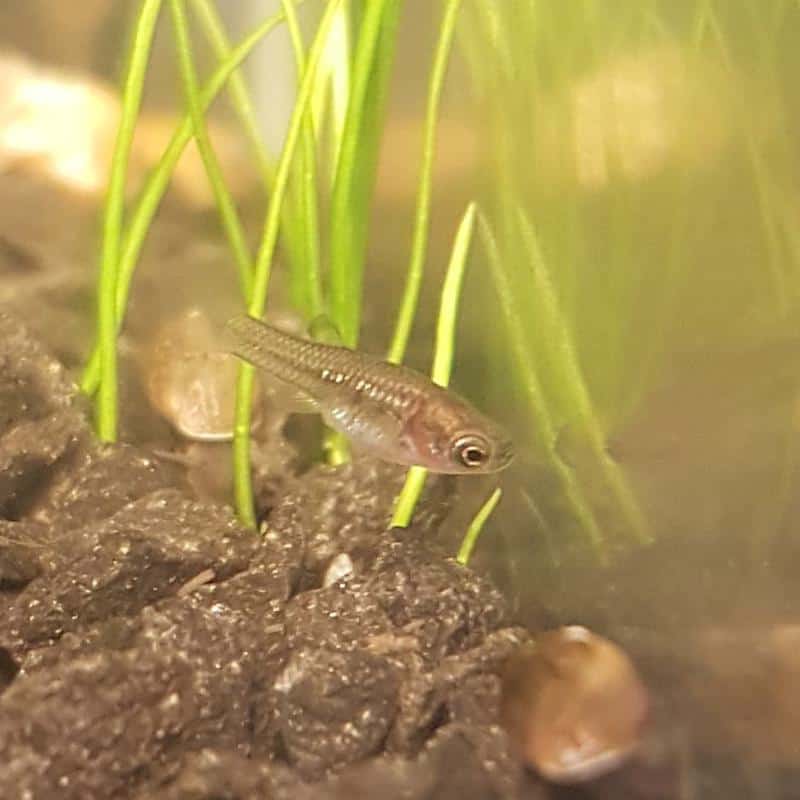
At first glance, you might confuse the dwarf molly with the common molly. Although they have similar appearances, dwarf mollies are smaller. They grow to a maximum length of only 2 inches. They also have smaller dorsal fins, unlike other types of mollies.
In the wild, dwarf mollies have a silver-gray body. But in captivity, they’ve been bred to feature a variety of colors including yellow, gold, red, etc. Dwarf mollies are also easy to care for and prefer a tank with plenty of swimming space, plants, and shelter.
3. Sailfin Molly
Another natural molly fish species is the sailfin molly. This aquarium fish can reach a length of 4-5 inches and live for up to 5 years.
Male sailfin mollies have a large dorsal fin that looks like a sail on a boat, hence the name. They often raise this fin to attract potential mates and scare off other males.
Like most molly fish, sailfin mollies can live in fresh and brackish waters. But in captivity, they prefer tanks with good filtration systems. The tank should have live plants and enough room for swimming. Also, aquarists should monitor and change the water frequently.
4. Yucatan Lyretail Molly Fish
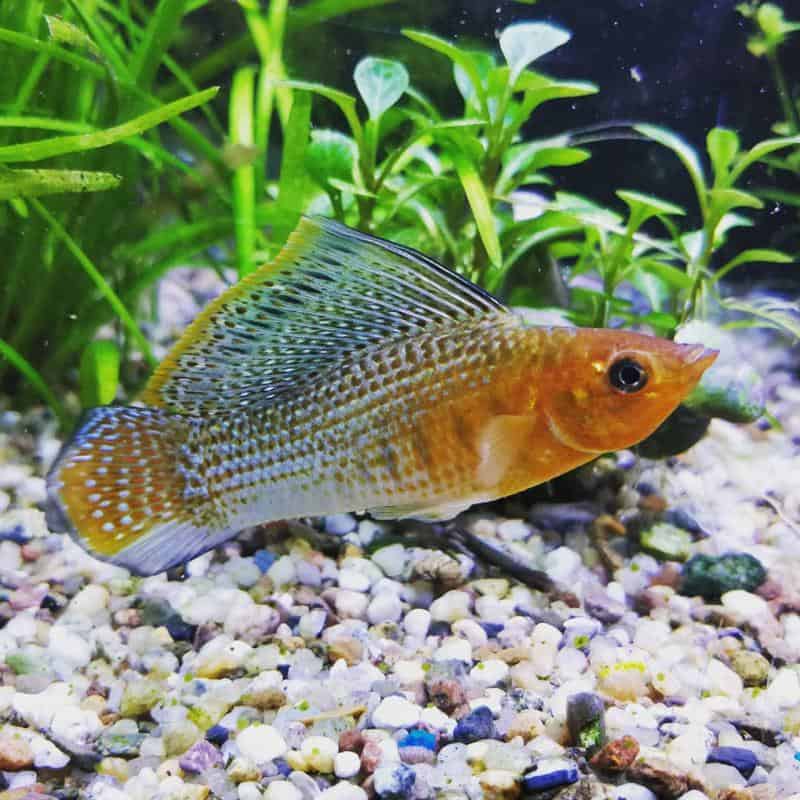
With a silver or tan body, the Yucatan Lyretail molly fish makes a great addition to community tanks. It looks like the common sailfin molly but can grow up to 7 inches, especially in the wild. Male Yucatan mollies also have a bigger dorsal fin featuring six additional rays.
Because of their large size, these molies require spacious tanks. If you opt to keep the Yucatan Lyretail molly, consider getting a 40 gallons tank. You might also need tank heaters, as these fish prefer warmer temperatures.
Although Yucatan mollies are peaceful, you should be careful when selecting tank mates. These mollies can bully smaller fish species, especially during mating season. Avoid keeping them with tiger barbs or other fish species that can nip their fins.
5. Liberty Molly
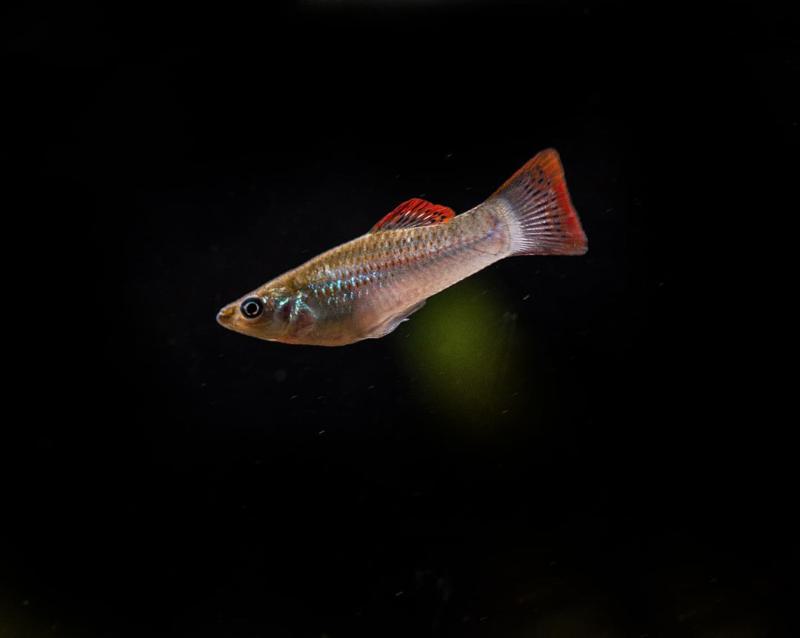
The liberty molly fish comes with a silver body with specks of blue and yellow, along with red fins and a tail. Like the common molly, it’s a hardy fish that can adapt to different environments.
Despite their small stature, liberty mollies are quite aggressive toward other fish. They tend to bite the fins and tails of other fish. As a result, they should be housed with small, fast fish.
Selectively Bred/Hybrid Mollies
One reason aquarists love mollies is that they are easy to breed. In fact, most molly fish sold at pet stores today are selectively bred to give rise to a variety of traits, including bright colors, unique patterns, and different fin shapes. Examples of popular hybrid mollies include:
6. Black Molly Fish
The black molly or common black molly is peaceful, social, and easy to care for fish. Like its cousin, the common molly, the black molly is hardy and can live in a variety of environments. For this reason, it’s the best aquarium fish for beginners.
Black mollies add color to any aquarium setting. As the name suggests, they rock a black shade with highlights of yellow on the fan-shaped tails. Some rare black molies feature orange specks spread throughout their bodies.
Since they can only reach an average size of 3 inches, black mollies don’t require large tanks. They can comfortably live in tanks that carry 15 to 30 gallons.
7. Black Sailfin Molly
With long flowing fins, the black sailfin molly comes with a unique dark black coloration. It can grow up to 4 inches and live for as long as 5 years.
Unlike the black molly fish, the black sailfin needs a spacious tank with open swimming spaces and live plants. Also, consider adding some decorations to provide fish shelter and places to explore.
Avoid housing the black sailfin with biting fish because they will nip its long-flowing tail-fin.
8. Balloon Molly Fish
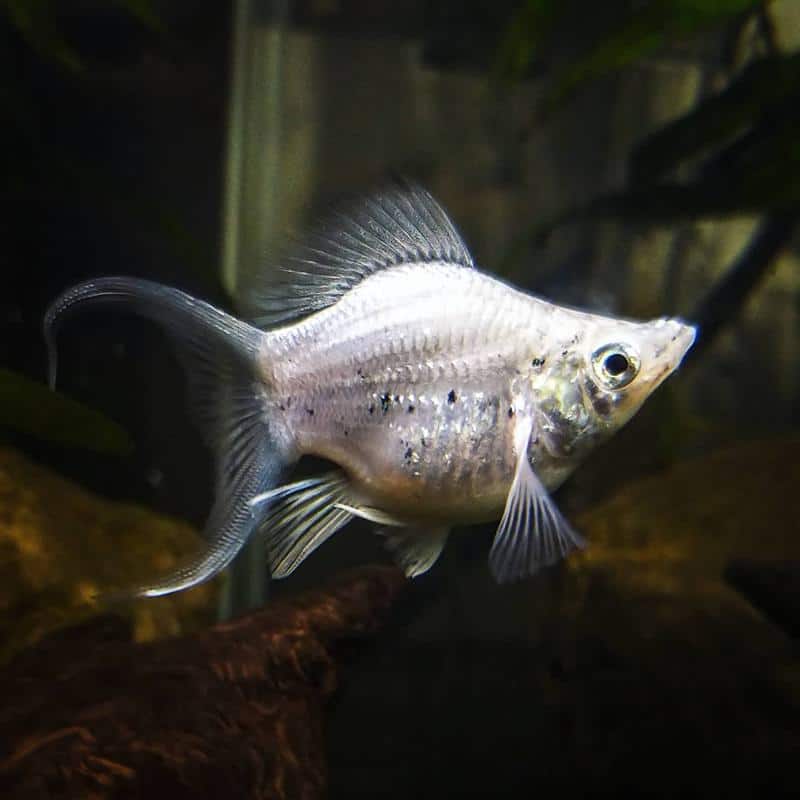
If you’ve never seen a balloon molly fish before, you’re in for a surprise. It looks like a product of bad breeding with its arched back and rounded belly. But surprisingly, they are quite hardy, with an ability to acclimate to varying salt levels.
Besides that, they are super active and curious. They spend most of their time swimming in a school and exploring the mid-region of the tank. As such, they can add a sense of activity and fun to small and big aquariums.
What’s more, they come in a variety of colors, including orange, silver-white, yellow, and black. The only downside is balloon molly fish require extensive care and have a short lifespan, approximately 1.5 to 2 years.
9. Dalmatian Molly
Here’s a fish version of the Dalmatian dog. Rocking an interesting black-and-white pattern throughout its body, the Dalmatian molly is a must-have aquarium fish. It’s a hybrid short-finned molly that grows up to 5 inches and prefers tanks with good filtration.
The Dalmatian molly is ideal for beginners and experienced aquarists, who want to improve their tanks’ aesthetic. They are active and can live peacefully with other fish in community tanks.
And since they are omnivores, they can consume a variety of vegetable-based flakes and live feeds like brine shrimp and bloodworms.
10. Harlequin Sailfin Molly
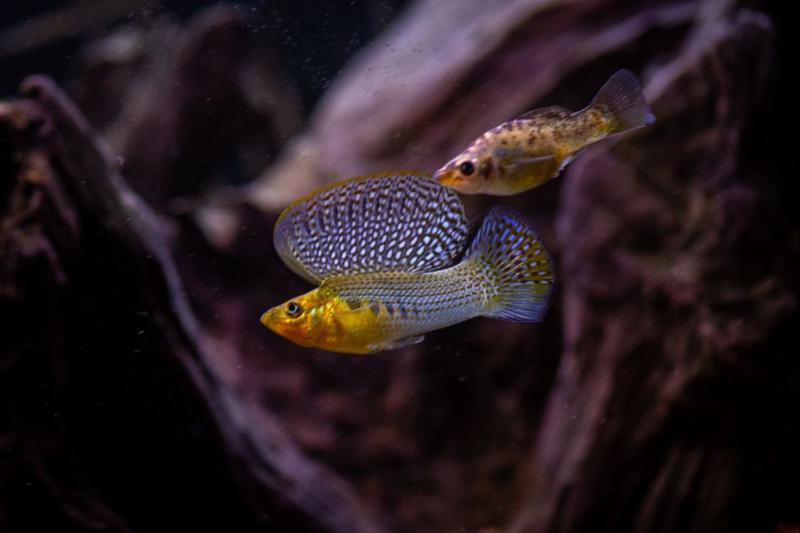
Another unique hybrid molly fish breed is the harlequin sailfin molly. This sailfin fish can grow up to 6 inches, and live for more than 3 years in an aquarium environment.
Instead of spots, the Harlequin mollies have black and gold streaks. Their fins and tails also display similar coloration with highlights of white and silver.
These mollies are peaceful and can co-exist with other fish species in the same environment. They prefer tanks with lots of plants, hiding spots, swimming spaces, and decorations. These mollies also require enough food to prevent them from eating live plants in the tank.
Molly Fish Care Requirements
Mollies stand out from other aquarium fish because they are easy to care for. But what does molly fish care involve? Well, this section breaks down established care guidelines for molly fish to thrive in tanks.
Water Parameters
In the wild, mollies dominate streams, rivers, lakes, deltas, shallows coastal waters, marshes, and swamps.
Since they are hardy creatures, they can adapt and thrive in environments with varying temperatures and pH levels. But for best results in an aquarium, aquarists must recreate the molly’s natural environment.
Let’s start with the temperature. Mollies prefer warm waters ranging between 72 and 80°F. If you live in a cold area, buy a water heater to raise the temperature and increase your molly’s chance of survival.
Molly fish thrive in both soft and hard water. But they will be happier if you add some minerals to the water. Fish experts recommend adding crushed coral substrate to the tank water to introduce calcium and carbonate.
As for pH, these fish thrive in neutral waters–7.0 to 8.0. Therefore, there’s no need to add salt to your aquarium to keep the molly healthy. It’s best to include a good filtration system to remove excess ammonia (NH3) and nitrate (NO3).
Another thing, don’t forget to monitor the water regularly and make the necessary changes.
Tank Size
Mollies can live in tanks as small as 15 gallons or less. However, the ideal tank size for these fish varies depending on the species and number of mollies you want to keep. For instance, the Yucatan Lyretail molly requires more tank space than the common molly because of its big size.
Also, if you want to keep more than one molly, increase the tank size by 3 or 4 gallons to ensure the mollies live happily. It’s best to select a bigger tank for mollies so they can move more freely and actively and stay healthy and happy.
Light
Generally, molly fish can adapt to a range of lighting conditions, but they don’t need high light levels to do well. However, live plants in the aquarium require light to grow.
For this reason, aquarium enthusiasts should provide planted aquariums with at least 1.5 to 5 watts of lighting power per gallon to support plant growth. But remember, too much light can increase algae growth in a tank, which can block the scenery and viewing area in the tank.
Tank Decorations and Plants
Molly fish flourish in tank environments that mimic their natural habitat. Therefore, you should add plenty of live plants, including dwarf lilies, Anubias, and Java ferns.
Use the substrate in the tank to anchor the live plants. You can also include several decorations, including caves to provide the fish lots of places to seek shelter.
Molly Fish Feeding Requirements
Because of their omnivore nature, molly fish can feed on plant-based food and meat. They like blanched vegetables, such as spinach, lettuce, and zucchini.
For a more balanced diet, give them live foods like brine shrimps, daphnia, and bloodworms. Alternatively, you can feed them with flakes and pellets sourced from trusted brands.
While they might not be great algae-eater like the Florida Flagfish, they frequently snack on algae growing on the tank’s glass, rocks, decorations, and plants.
Feed your molly fish two or three times a day. But avoid overfeeding the fish, because they develop problems like bloating. Furthermore, excess food will affect the water quality.
Social Behavior and Temperament
Molly fish are generally peaceful and can co-exist with other mates in a community tank. They are also active swimmers and love exploring everything in the tank.
Since they are a shoaling species, they prefer living with other mollies to socialize and feel comfortable. According to experts, fish keepers should keep mollies in a group of about three or four members. The larger the group, the better.
But despite their gentle nature, they can display signs of aggression, especially if you keep more males than females. The males might become territorial and even fight during breeding. They can also harass the females and cause them stress. Prevent this behavior by keeping more females than males in the same aquarium.
Suitable Tank Mates for Molly Fish
Since mollies are peaceful, they can get along with other peaceful tank mates of the same size. But they can become aggressive if the tank is overcrowded. The best tank mates for mollies include:
- Danios
- Guppies
- Platys
- Tetras
- Cherry Barb
- Zebra Loach
- Swordtails
- Cory Catfish
- Dwarf Gourami
- Harlequin rasbora
- Some cichlid, like ram cichlids and dwarf cichlids
- Zebra and Yoyo Loach
Mollies can also co-exist with several invertebrates, including:
- Snails
- Shrimp
- Algae-eating carbs
Avoid housing mollies with aggressive or large fish that can bully and cause them stress.
Common Health Problems
Molly fish might be a hardy fish species, but they are susceptible to some diseases. A sick molly fish will display the following signs:
- Loss of appetite and color
- Weight loss
- Bloating or constipation
- Cloudy eyes
- Erratic swimming
- Fungus on the mouth and body
- Frayed fins
- Listlessness
Several diseases can cause these signs and symptoms. The most common illnesses include:
Shimmies
Shimmy is a common condition in mollies and other livebearers. However, it’s not a disease but a symptom of stress.
Shimmies force the fish to rock from side to side. It occurs due to altered tank conditions. This could be extreme fluctuations of water pH levels, mineral levels, or temperature.
The best way to address shimmies is to provide mollies with proper water requirements and monitor water conditions regularly.
Fin Rot
As the name suggests, this disease affects the fins and tails of mollies, causing them to change color or deteriorate. Sometimes, the fish could lose the infected fins or tails.
Fin rot is a bacterial infection, but its root cause is a weakened immune system. This happens when a fish is subjected to poor water conditions or placed in an overcrowded tank with biting or nipping fish.
Fortunately, mollies with fin rot can recover with treatment and proper tank maintenance.
Ich
Another common molly fish disease worth highlighting is ich, white spots, or ick. It’s an infection caused by parasites that causes white spots (like sugar or salt grains) on your molly’s skin and gills. Sometimes, you might see your pet fish rubbing or scratching itself against a hard object like decorations.
Aquarists can address this problem by placing the infected fish in quarantine and calling a veterinarian. The specialist will examine the fish, provide a diagnosis and suggest the most effective treatment.
Besides these, mollies are also prone to fungus infections, parasites, and flukes.
Breeding Molly Fish
Molly fish breed a lot and often require no innervations from humans. A healthy female molly can spawn several times throughout its life, producing over 50 new offspring a time.
Mollies display no parental instincts because the adults usually feed on the young ones. But you can increase their survival rate by introducing dense aquarium plants, such as water wisteria and sprite, which can provide shelter and hiding spots. You can also transfer the new fry to a breeding tank with controlled water conditions.
Because mollies are livebearers, their fry starts fully formed and can even eat tiny pieces of flakes, pellets, and live baby brine shrimp. With proper diet and water conditions, the fry can take about 9 months to reach juvenile size. At this stage, they are ready for re-homing.
Also Read:
Wrapping Up
Based on the information above, it’s easy to understand why molly fish is quite popular among aquarists. They are low-maintenance, peaceful, active, and visually appealing. If that’s not enough, they help clean the tank by eating algae.
With proper care, mollies can grow healthy and happy and provide you with entertainment and joy for several years. So, if you are searching for a stunning and fun aquatic pets, get yourself a molly fish.
If you have any questions about mollies, leave us a comment below.
